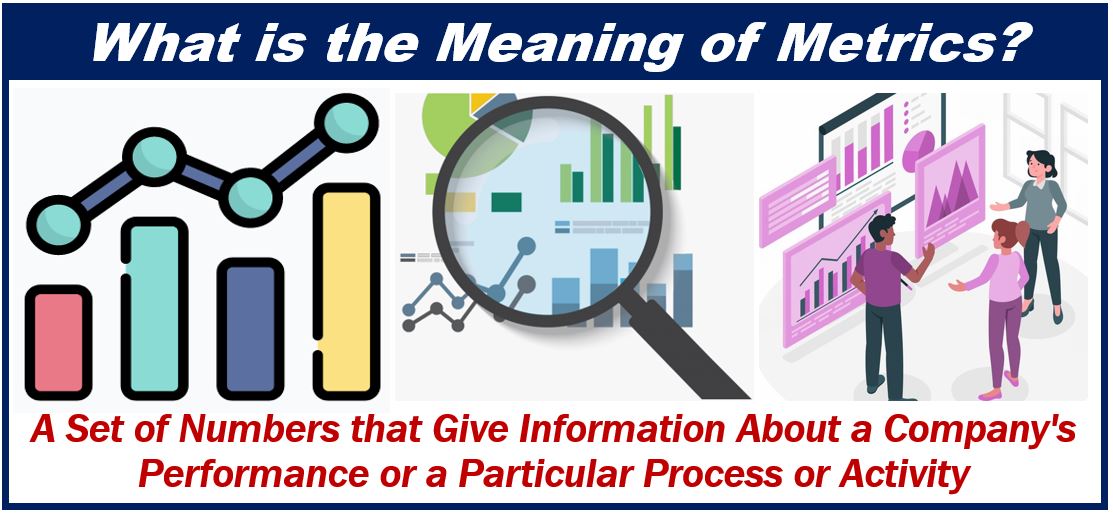Metrics are numbers and statistics that we use to measure or track performance. In a business, we use metrics to assess how well a department, production unit, sales team, or website has been performing. Put simply; it is a system of measurements.
When analyzed over time, metrics can provide predictive insights, helping businesses forecast trends and make proactive decisions.
Most people view metrics on an online dashboard. A dashboard is a graphical user interface that provides users with views of crucial performance statistics and indicators.
Metrics matter for many stakeholders
Analysts and webmasters review the dashboard regularly. Metrics are also of interest to key stakeholders such as customers, prospects (potential customers), middle and upper management, and investors. Stakeholders are people who have an interest in a company, organization, or other type of entity.

Most business strategy decisions, in fact, are only made after a careful analysis of and discussion about the latest metrics.
Why are they important for business success?
We use business metrics to encourage improvement. They also tell us where to focus our time, effort, and money. Which metrics you should employ may vary, depending on the kind of business you are in and the laws of your country. For safety, contractual, and legal purposes, some systems of measurement are compulsory.
If you have selected the right figures and statistics to analyze, they will tell you:
- Where your business has been.
- Where it is going.
- What parts of it are doing well or badly.
- How far your company is from its targets, goals, and objectives.
Metrics are crucial for salespeople
If you sell website advertising space, you will talk to potential clients. You will explain what benefits they will get by advertising on your site. Perhaps, for example, your visitors are similar to their target consumers.
If you work for an online gardening newspaper and you are talking to the Advertising Manager of Super Lawns Inc., who are sellers of lawn mowers, your visitors and their target consumers will be virtually identical. This means that if they advertise on your website, a major proportion of ad viewers and inquirers will be potential lawn mower purchasers.
If you don’t provide metrics during your presentation, the Ad Manager will either lose interest or ask for them. In fact, virtually nobody today will go ahead with any online advertising offer without having a careful look at the metrics.
The Ad Manager will want to know how many visitors you have, what your bounce rate is, as well as some conversion rates. Bounce rate refers to the percentage of people who leave your site rather than moving onto another page within it. Conversion rate, in this context, refers to the percentage of visitors or inquirers who buy something.
All these statistics are part of the metrics, i.e., numbers and statistics that show how well or badly your website performs. Interestingly, some CEOs have commented that knowing where things are wrong matter more than anything else.
Keep it simple
Don’t make the mistake of including too much in your metrics, or trying to make it look super-sophisticated. Only use relevant material, i.e., keep it as simple as you can.
You should be able to glance at it and get the relevant information you were looking for rapidly, and perhaps even instantly. If you want company employees, members of your team, investors, or customers to understand the contents of a dashboard, keep it simple.
You may, for example, be trying to persuade your team to adopt a new strategy. However, if they cannot fully appreciate why, your chances of succeeding will be slim.
It is essential to periodically review and adjust the metrics themselves to ensure they remain aligned with evolving business goals and market conditions.
Metrics vs. econometrics
Econometrics
This term refers to the application of statistical and mathematical methods to describe economic systems. It also involves using statistical and mathematical theories to test hypotheses and forecast future trends.
Metrics
A set of statistics and numbers that tell us about a company’s performance or a specific function or activity. Metrics provide information on how well or badly we are doing and whether we are going the right way.
